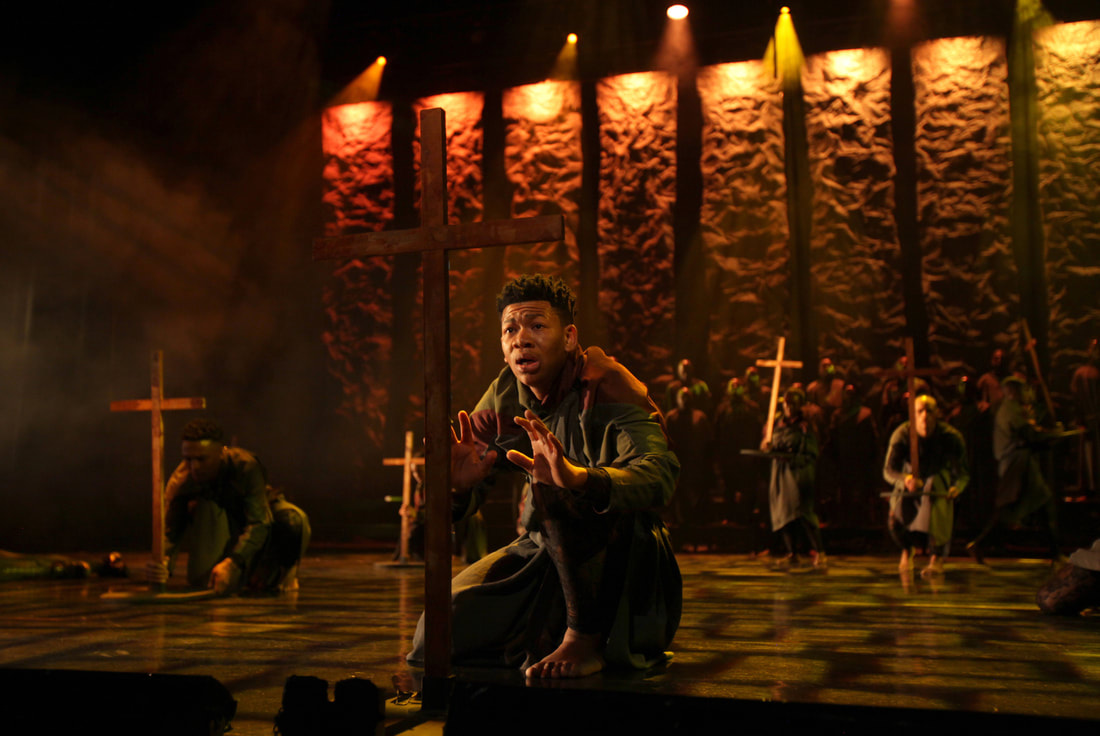|
Vuyani Dance Theatre performed its tour de force "Cion: Requiem of Ravel's Bolero" at MassMoCA on Saturday night. It started in blackness with the sound of weeping – muted and gentle at first but then it grew into a full-fledged wail – one that echoed through the Hunter Center at MassMoCA on Saturday night.
As the lights rose, the audience saw the mourner shuffling among crosses – a graveyard that encircled the stage and set up Gregory Maqoma’s powerful and resonate “Cion: Requiem for Ravel’s Bolero.” As performed by nine ardent and talented dancers from South Africa’s Vuyani Dance Theatre along with four amazing vocalists from Soweta’s Gospel Choir, the work is a haunting indictment of religious authority in a world filled with despair. And while there were glimmers of joy and even hope, the piece is a cautionary tale, one that exhorts us all to wake up to the pain in the world that we ourselves are upholding – often by our unconscious neglect and indifference. Dancer Otto Andile Nhlapo danced the central role – a potent priest who in the first minutes demonstrated his sway with a wave of his arm that moved the others to do his bidding. He presided over the ensemble that was at first meek but allowed the pain and anger to bubble up and over into a cauldron of ferocity. After submission, with imagery akin to communion, the dancers turned on the priest – pounding on him and eventually taunting him. And this was just the beginning. The music for the journey into grief was outstanding. At first, the four voices from the quartet – Simphiwe Bonongo, Xolisile Bongwana, Sibusiso Shozi and Thabang Mkhwanazi – sounded so precise and so substantial, I was certain it was a recording of a large group of singers and musicians. But when the lights rose up on them, I could see that it was from these gifted vocalists doing the broad soundscape purely a capella. When they created Ravel’s iconic “Bolero” with their voices, I was stunned. That in itself was a worthwhile listening experience - an orchestra of sound from four. Back to the dancers – they performed this miracle with Maqoma’s unique language that combined modern, ballet, African, street, martial arts and tap dance. Nhlapo’s role was a tour de force, requiring him to be onstage nearly the entire 70 minutes -- working out his character’s inherent cruelty to find a place where love can seep in. While Nhlapo was engrossing to watch, every second of the ensemble work was enthralling. It shouted pain, especially during the section where they are pounding the floor with a bundle of cloth. Their unity, honesty and willingness to go for broke was mesmerizing. There was no way to turn from its awesome might. “Cion: Requiem for Ravel’s Bolero” is an amazing artistic achievement and one that makes me curious as to what else is out there in modern African dance. For decades, the only thing American audiences saw were the traditional dance and music troupes. While those groups are rightly beloved, I want to see more Vuyani and those like it from Africa. Obviously, the mysterious continent has much to offer.
0 Comments
Leave a Reply. |
Wendy
|

 RSS Feed
RSS Feed
